Hello, fellow garden enthusiasts! Today, we’re going to explore a simple yet effective technique that will revolutionize your basil cultivation – pruning for endless growth. Basil is a plant that thrives on aggressive pruning, and with a few clever techniques, you can create a basil plant that is bushy, productive, and delicious.
Understanding the Basil Plant
The basil plant, scientifically known as Ocimum basilicum, is a popular culinary herb that has been cherished for its aroma, flavor, and versatility in dishes across various cuisines. Originating from Southeast Asia and Africa, basil has a long history of use in traditional medicine, with many cultures recognizing its potential health benefits. Understanding the characteristics and growing requirements of this delightful herb can help you enjoy its fresh, fragrant leaves in your own garden or kitchen, elevating your culinary creations to new heights.
Basil is an annual plant that thrives in warm weather and well-draining soil, making it an ideal choice for home gardens and container planting. The plant requires plenty of sunlight – at least six hours of direct sun per day – and consistent watering to ensure healthy growth. Basil comes in numerous varieties, each offering its unique flavor profile and appearance, such as the sweet Genovese basil, the spicy Thai basil, or the visually striking purple basil. To harvest basil, simply pinch off the leaves as needed, taking care to remove any flowers that may appear, as they can cause the plant to become bitter. Regular harvesting encourages bushier growth and prolongs the life of the plant. Not only is basil a delicious addition to dishes like pesto, salads, and pasta, but it also boasts potential health benefits, such as its antioxidant and anti-inflammatory properties. By incorporating basil into your garden and your meals, you can enjoy the vibrant flavors and aromas it brings while reaping the rewards of this delightful and versatile herb.
The Pruning Process for Basil Leaves
The process is straightforward. Let’s take a closer look at the basil plant. You’ll notice that it has a main stem. When you cut this main stem, you remove the growth hormone from the plant, causing it to redistribute itself to the other stems. This results in the growth of new, bushy stems, leading to a more productive plant.
To replicate this, you would chop the new main stem, causing the nodes (or “little hands”) to become the new main stems. As these grow, they will produce new vegetation, leading to a bushier plant.
Pruning to Get A Bushy Plant
When it is time to prune basil, you want to think strategically with it. You encourage the growth of new stems that will grow outwards, creating a bushier plant and continuing to produce vegetation instead of moving into the flowering phase. This technique, when done repeatedly and intelligently, will result in a basil plant that never starts flowering, as flowers are never allowed to develop on the plant.
As long as you maintain the right light conditions and provide the plant with the necessary nutrition, water, and oxygenation, you can enjoy an endless supply of basil.
The Benefits of Pruning
The benefits of this pruning technique are twofold. Firstly, you get a basil plant that continues to produce vegetation, providing you with a constant supply of fresh basil. Secondly, you prevent the plant from flowering, which often signals the end of the plant’s life cycle. When the basil flowers come out, you know you messed up.
What’s the Difference Between Pruning and Trimming Your Basil Plant?
When it comes to maintaining the health and productivity of your beloved basil plants, understanding the difference between pruning and trimming can make a significant impact on their overall growth and yield. Both practices play essential roles in promoting strong, vibrant basil plants that produce an abundance of fresh, aromatic leaves for your culinary masterpieces. By learning the nuances of pruning and trimming, you can ensure that your basil plants thrive and continue to enhance your garden and kitchen creations.
Pruning refers to the practice of selectively removing specific parts of a basil plant to encourage bushier growth, which ultimately leads to more leaves for harvest. This process involves pinching off the growing tips of the plant just above a leaf node, where two leaves emerge from the stem. By doing so, you stimulate the growth of two new branches at that node, resulting in a fuller, more robust plant. Pruning also helps prevent the plant from becoming too tall and leggy, which can lead to weaker stems and reduced leaf production. On the other hand, trimming is the act of cutting back or removing excess foliage, especially older, larger leaves, to allow sunlight to reach the inner parts of the plant. This practice helps maintain the overall shape and health of the basil plant, as well as promoting air circulation and reducing the risk of pests and diseases. Trimming also provides you with a steady supply of fresh basil leaves to use in your favorite recipes. By incorporating both pruning and trimming techniques into your basil plant care routine, you can optimize the growth, appearance, and productivity of these delightful herbs.
Final Thoughts
The best part about your basil harvest is that after you trim it, it will grow back, producing leaves and more leaves. So if you are as excited to grow basil as I am, you’ll be needing to get some seedling and here is my recommendation: Bonnie Plants Sweet Basil Live Herb Plants – 4 Pack
Happy gardening!
Pruning Basil for Growth FAQ
What is pruning?
Pruning is a crucial gardening practice that involves the selective removal of specific plant parts, such as branches, buds, or roots, to promote healthy growth, maintain the desired shape, and improve overall plant performance. This technique not only encourages the development of a strong, well-balanced structure but also helps prevent the spread of pests and diseases by removing damaged or diseased plant material. Pruning can be applied to a wide range of plants, including trees, shrubs, and herbs, ensuring that your garden remains vibrant, productive, and visually appealing. By incorporating proper pruning techniques into your gardening routine, you can enhance the health, longevity, and beauty of your plants while maximizing their potential in your outdoor space.
Why should I prune my basil plant?
Pruning your basil plant is an essential practice that offers numerous benefits, ensuring that your herb thrives and produces an abundance of fresh, flavorful leaves for your culinary creations. By regularly pruning your basil, you not only maintain its overall health but also encourage bushier growth, leading to a fuller and more robust plant. This simple yet effective technique can significantly improve the productivity and appearance of your basil, making it a must-know skill for any home gardener or herb enthusiast.
The primary reason to prune your basil plant is to stimulate the growth of new branches, which in turn results in increased leaf production. Pruning involves pinching off the growing tips just above a leaf node, prompting the plant to develop two new branches at that point. This process helps prevent the basil from becoming too tall and leggy, which can lead to weaker stems and reduced leaf yield.
Additionally, regular pruning discourages flowering, as basil plants tend to produce fewer leaves and lose some of their flavor once they start to flower. By delaying the flowering process through pruning, you can extend the harvesting period and enjoy a continuous supply of fresh basil leaves throughout the growing season. In essence, pruning your basil plant is a simple yet impactful practice that fosters healthy growth, increased productivity, and enhanced flavor, making it a vital component of your herb care routine.
How often should I prune my basil plant?
You should prune your basil plant every two to three weeks, or when it starts to produce big leaves. Regular pruning will promote the growth of new branches, and cutting off the top of the plant will prevent it from becoming too tall. That is why it is so important to trim basil.
What is the best way to prune basil?
The best way to prune basil is to use a pair of sharp scissors or pruning shears to cut the basil stem back to just above a pair of tiny leaves or a set of new leaves. Trimming the basil stems will help prevent them from becoming woody.
How do I stimulate growth when pruning?
To stimulate growth when pruning basil, make sure to prune the basil stems back to just above a set of new branches or leaves. This will encourage the plant to produce more foliage and prolong its life.
Can I harvest basil leaves right after pruning?
Yes, you can harvest basil leaves right after pruning. In fact, pesto, salads, and other dishes made with fresh basil often use leaves that have been cutting back or pruned from the plant. Just make sure to keep the plant watered and nutrients replenished to ensure it continues to grow.
Should I prune basil plants regularly?
Yes, you should prune basil plants regularly to keep them from becoming too bushy and to encourage new growth. Regular <






